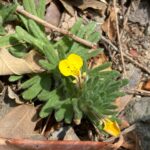Αγιούγκα η χαμαιπίτυς υποείδος η παλαιστίνια
Etymology of Ajuga chamaepitys subspecies palaestina: The name of the genus, "Ajuga", was borrowed from New Latin, probably from a mistaken reading of Latin "abiga", which was a name for a plant of the genus (as Ajuga chamaepitys), taken by Pliny the Elder as a derivative of Latin "abigere", meaning "to drive away, reject, dispel," from the use of the plant as an abortifacient. The genus Ajuga was initiated by Linnaeus in Species plantarum, vol. 2 (Stockholm, 1753), p. 561. The plant name ajuga appears in sixteenth-century editions of Pliny's Historia naturalis (book 24, chapter 19) and in Latin translations of Dioscorides, sometimes alongside abiga. The ultimate source of the misreading has apparently not been determined. Ancient Greek "chamaepitys" comes from "χαμαί" [chamae], meaning "on the earth/ground" and ''πίτυς" [pitys], meaning "pine", hence "ground pine", referring to the formation of the plant that supposedly resembles a pine branch. It is called "palaestina" because it is native to the region of Palestine.
There are four Ajuga taxa growing without human intervention in Cypriot nature.
Ajuga chamaepitys subsp. palaestina is an uncommon plant in Cyprus, which doesn't grow in the northeastern part and the central plains of Cyprus. It appears up to an altitude of 1025 metres. Its flowering period is between January and May.

